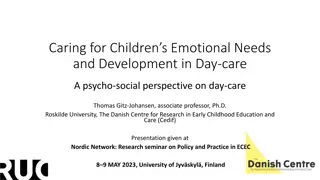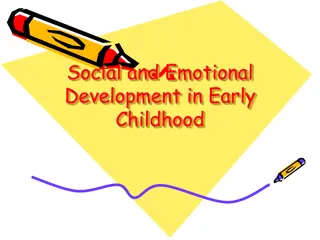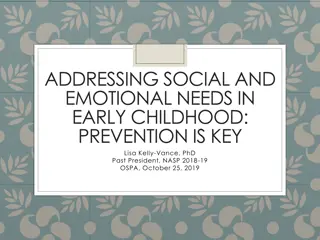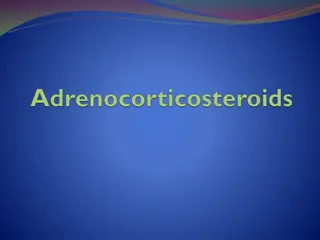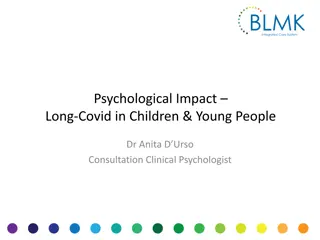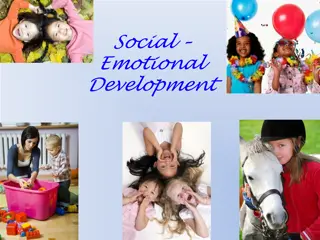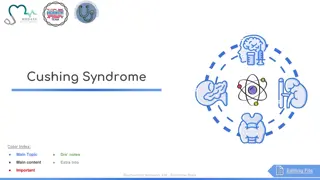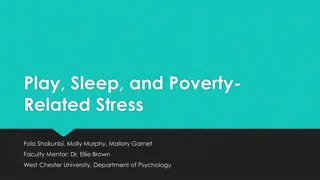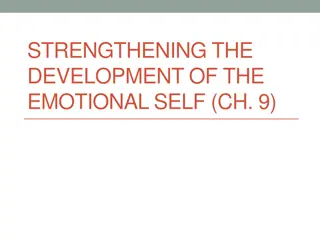Understanding the Impact of Cortisol on Emotional Expression in Young Children Facing Economic Hardship
This study explores how the stress hormone cortisol is related to emotional expression in young children experiencing economic hardship. Cortisol levels can indicate stress, but prolonged exposure to stress can lead to desensitization. The research focuses on children attending Head Start preschools and aims to uncover how cortisol levels influence their emotional experiences amidst challenging environments and poverty-related stressors. The study underscores the significance of investigating cortisol's role in early childhood development and its effects on cognitive, social-emotional, and physical health.
Download Presentation

Please find below an Image/Link to download the presentation.
The content on the website is provided AS IS for your information and personal use only. It may not be sold, licensed, or shared on other websites without obtaining consent from the author. Download presentation by click this link. If you encounter any issues during the download, it is possible that the publisher has removed the file from their server.
E N D
Presentation Transcript
Stress Hormone Cortisol Relates to Emotion Expression for Young Children facing Economic Hardship Corinne Yost, Jessa Malatesta, Alyssa Allen, Zachary Weaver, Keara Hennesey, Kaytlin Landis-Rotondi, & Mallory Garnett Faculty Mentor: Eleanor Brown
Acknowledgements This research was supported in part by West Chester University's former College of Arts and Sciences (now College of Sciences and Mathematics) and Department of Psychology. A different study based on the same broad investigation received support from the Research: Art Works program at the National Endowment for the Arts (NEA): Grant #13-3800-7004 and some descriptive statistics for the present sample have been presented previously in relation to the NEA award. We appreciate the collaboration on this project with Settlement Music School's Kaleidoscope Preschool Arts Enrichment Program. Special thanks to Early Childhood Director, Tarrell Davis. We are grateful also to the preschool teachers and families who contributed. We appreciate the West Chester University Early Childhood Cognition and Emotions Lab (ECCEL) researchers who assisted with this project, and would like to specifically acknowledge Blanca Velazquez-Martin, Keriann Mosley, and Savina Lawrence. Correspondence concerning this Presentation may be addressed to Eleanor D. Brown, PhD, Wayne Hall Rm 540, Department of Psychology, West Chester University, West Chester, PA 19383. Phone: 610-436-3153. Fax: 610- 436-2846. Email: ebrown@wcupa.edu
Background Around 40% of children in the US face economic hardship Related stressors influence physiological functioning and brain development The hormone cortisol indicates stress In general, higher cortisol indicates more stress, but repeated exposure to stress can eventually lead to depressed cortisol (desensitization to stress) Given the complexities, we don't know for sure how children's cortisol levels relate to their emotional experience This study focuses on how cortisol levels relate to expressed emotion for children attending Head Start preschools
Impact of Poverty Stressors related to poverty include: o Financial hardship o Neighborhood violence o Inadequate material resources o Instability in where and with whom children live Effects include: o Problems in cognitive, social-emotional, and physical health
HPA Functioning Hypothalamic-pituitary-adrenal or HPA axis o Physiological stress response system o Activity measured by end-product stress hormone cortisol o Cortisol follows diurnal pattern o Levels contribute to functioning of metabolism, immune support, learning, and memory o Facilitates effective response to challenging environments HPA dysregulation o Over exposure to stress leads to overtaxing physiological systems and specific brain areas such as the prefrontal cortex o Effects are particularly important in early childhood when there is rapid brain growth and development
Diurnal Cortisol and Stress Response Diurnal Pattern Peak in morning Steep decline in mid morning Gradual decline rest of day Follows sleep-wake circadian rhythm Salimetrics LLC
How Cortisol Dysregulation May Help to Explain Impact of Poverty on Child Development Cumulative impact of poverty cofactors o Neighborhood violence o Inadequate material resources o Instability in where and with whom children live Allostatic load o Tax on physiological systems, including the HPA o Includes cortisol dysregulation Birth-6 years Critical period Rapid growth and development of prefrontal cortex, which has to do with learning and self-regulation Cortisol dysregulation can interfere with development
Complexities about Dysregulation Dysregulation due to poverty-related stress can disrupt the normal diurnal pattern of cortisol functioning Hypercortisolism: This is the most common pattern for children facing economic hardship in the United States and represents sensitization to stress Elevated baseline cortisol levels Over-reactivity to stressors, and inefficient return to baseline Hypocortisolism This pattern may emerge with severe or chronic stress or trauma, and represents attenuation or desensitization Depressed baseline cortisol levels Under-reactivity to stressors We know that both of these patterns of dysregulation are linked to negative child emotional and behavioral outcomes Given diurnal variation and dynamic nature of stress-response systems, we don't know for sure what particular cortisol levels mean for children's emotional experience and behavior
Importance of Child Emotion Expression According to Differential Emotions Theory (DET; Izard et al.): Discrete emotion systems play an important role in explaining behavior Emotions are activated in response to environmental experiences, giving rise to characteristic patterns of emotions, cognitions, and actions Emotions have adaptive functions e.g., interest: sustaining engagement and attention High frequency and intensity is maladaptive Observed emotion expression offers excellent snapshot of children s preschool experience
Present Study Extension of broad investigation of Brown et al. Focus on preschool children facing economic hardship Examines relations between cortisol and emotion expression and behavior Utilizes HPA end factor cortisol as physiological marker of function and development as well as parent demographic interview and well validated observational coding system for child emotion expression and behavior
Participants 70 children attending a Head Start preschool in Philadelphia, PA Mean age = 4 years and 1 month 52.3% female, and 47.7% male 54.5% Black/ African American, 15.2% Latino/ Hispanic American, 10.3% Asian American, and 20.0% White/ European American
Procedure All procedures approved by WCU IRB Study included: o Parent demographic interviews at start of school year o Measurement of child cortisol levels via salivary assay 4 times a day on 6 different days throughout school year o Coding of children s emotion expression within classes prior to cortisol measurement using AFFEX (Izard, Dougherty, & Hembree, 1989) AFFEX coding system: Grounded in DET Provides a sufficiently reliable and time-efficient affect expression identification system Based on cross-cultural research, and developmental studies of infants and young children
Descriptive Statistics and Zero-order Correlations
Results Zero-order correlations: Preliminary zero-order correlational analyses indicated that the lower cortisol related significantly to the emotion of interest and to behavior that was coded as within normal limits or overcontrolled as opposed to hyperactive. Higher cortisol related significantly to the emotion of anger and behavioral expression of defiance. We are in the process of acquiring statistical software that will allow us to carry out more sophisticated analyses that will appropriately account for the nested structure of these data, with observations of cortisol nested within children, nested within preschool classes.
Summary and Implications This is the first study we know of to examine relations between child cortisol levels and their observationally coded emotion expression and behavior Preliminary results indicate that lower cortisol relates to the emotion of interest, and to behavior that is within normal limits or overcontrolled as opposed to hyperactive Preliminary results further indicate that higher cortisol relates to the emotion of anger and to expressions of defiance These results add uniquely to the current knowledge base and suggest that: For children facing economic hardship, cortisol levels often are already elevated due to poverty-related stress and thus, those with higher cortisol in comparison to their peers may be at particular risk for difficulties o Interventions that aim to lower stress levels for children facing economic hardship may be linked to positive changes in children's emotions and behavior o
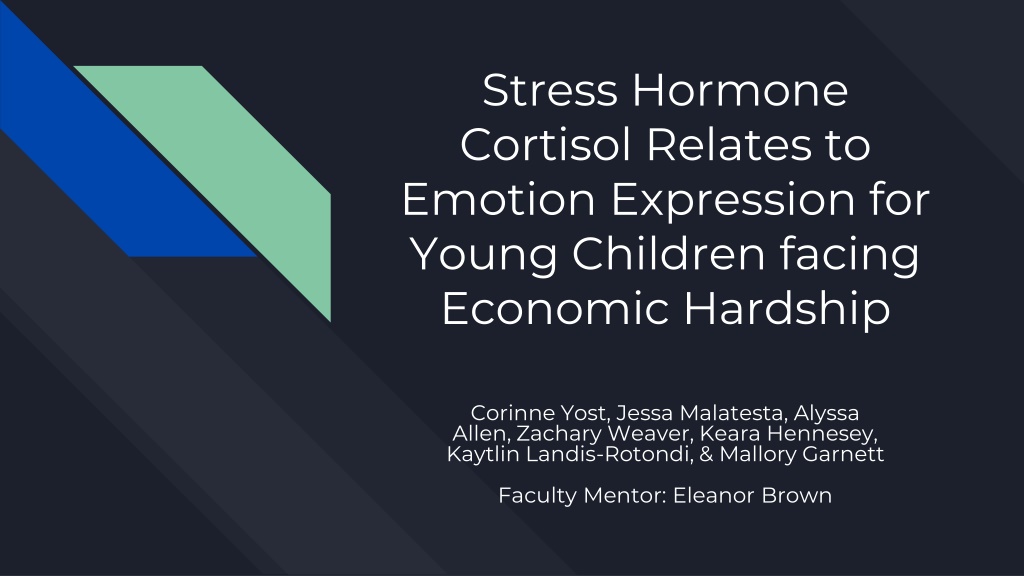

![Financial hardship and the economic burden of health [cancer] care](/thumb/779/financial-hardship-and-the-economic-burden-of-health-cancer-care.jpg)


